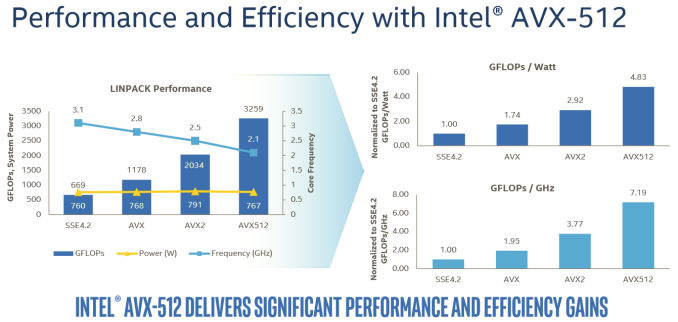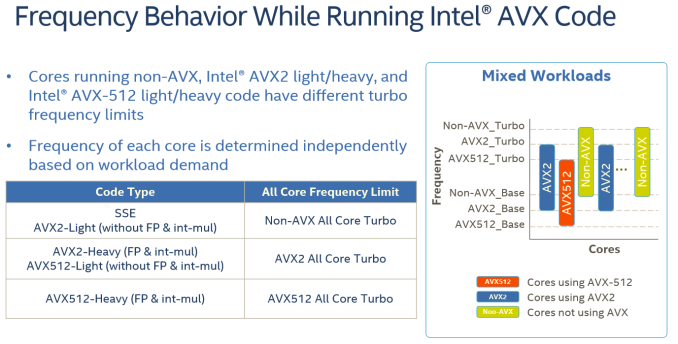Sizing Up Servers: Intel's Skylake-SP Xeon versus AMD's EPYC 7000 - The Server CPU Battle of the Decade?
by Johan De Gelas & Ian Cutress on July 11, 2017 12:15 PM EST- Posted in
- CPUs
- AMD
- Intel
- Xeon
- Enterprise
- Skylake
- Zen
- Naples
- Skylake-SP
- EPYC
Introducing Skylake-SP: The Xeon Scalable Processor Family
The biggest news hitting the streets today comes from the Intel camp, where the company is launching their Skylake-SP based Xeon Scalable Processor family. As you have read in Ian's Skylake-X review, the new Skylake-SP core has been rather significantly altered and improved compared to it's little brother, the original Skylake-S. Three improvements are the most striking: Intel added 768 KB of per-core L2-cache, changed the way the L3-cache works while significantly shrinking its size, and added a second full-blown 512 bit AVX-512 unit.
On the defensive and not afraid to speak their mind about the competition, Intel likes to emphasize that AMD's Zen core has only two 128-bit FMACs, while Intel's Skylake-SP has two 256-bit FMACs and one 512-bit FMAC. The latter is only useable with AVX-512. On paper at least, it would look like AMD is at a massive disadvantage, as each 256-bit AVX 2.0 instruction can process twice as much data compared to AMD's 128-bit units. Once you use AVX-512 bit, Intel can potentially offer 32 Double Precision floating operations, or 4 times AMD's peak.
The reality, on the other hand, is that the complexity and novelty of the new AVX-512 ISA means that it will take a long time before most software will adopt it. The best results will be achieved on expensive HPC software. In that case, the vendor (like Ansys) will ask Intel engineers to do the heavy lifting: the software will get good AVX-512 support by the expensive process of manual optimization. Meanwhile, any software that heavily relies on Intel's well-optimized math kernel libraries should also see significant gains, as can be seen in the Linpack benchmark.
In this case, Intel is reporting 60% better performance with AVX-512 versus 256-bit AVX2.
For the rest of us mere mortals, it will take a while before compilers will be capable of producing AVX-512 code that is actually faster than the current AVX binaries. And when they do, the result will be probably be limited, as compilers still have trouble vectorizing code from scratch. Meanwhile it is important to note that even in the best-case scenario, some of the performance advantage will be negated by the significantly lower clock speeds (base and turbo) that Intel's AVX-512 units run at due to the sheer power demands of pushing so many FLOPS.
For example, the Xeon 8176 in this test can boost to 2.8 GHz when all cores are active. With AVX 2.0 this is reduced to 2.4 GHz (-14%), with AVX-512, the clock tumbles down to 1.9 GHz (another 20% lower). Assuming you can fill the full width of the AVX unit, each step still sees a significant performance improvement, but AVX2 to AVX-512 won't offer a full 2x performance improvement even with ideal code.
Lastly, about half of the major floating point intensive applications can be accelerated by GPUs. And many FP applications are (somewhat) limited by memory bandwidth. While those will still benefit from better AVX code, they will show diminishing returns as you move from 256-bit AVX to 512-bit AVX. So most FP applications will not achieve the kinds of gains we saw in the well-optimized Linpack binaries.













219 Comments
View All Comments
CajunArson - Tuesday, July 11, 2017 - link
Would a high-end server that was built in 2014 necessarily update? Maybe not.Should a high-end server with a brand new microarchitecture use the most recent version of the software if it has any expectation of seeing a real benefit? Absolutely.
If this was a GPU review and Anandtech used 2 year old drivers on a new GPU (assuming they even worked at all) we wouldn't even be having this conversation.
BrokenCrayons - Tuesday, July 11, 2017 - link
Home users playing video games are in a different environment than you find in a business datacenter. There's a lot less money to be lost when a driver update causes a performance regression or eliminates a feature. Conversely, needlessly updating software in the aforementioned datacenter can result in the loss of many millions if something goes wrong.wallysb01 - Tuesday, July 11, 2017 - link
Conversely, having stuff working, but unnecessarily slowly costs money as well. Its a balance, and if you're spending hundreds of thousands or even millions on a cluster/data center/what have you, you'd probably want to spend at least a little bit of time optimizing it, right?Icehawk - Tuesday, July 11, 2017 - link
Most of the businesses I have worked for, ranging from 10 people to 50k, use severely outdated software and the barest minimum of patching. Optimization? HA!For example I work for a manufacturer & retailer currently, our POS system was last patched in 2012 by the vendor and has been replaced by at least two versions newer. We have XP machines in each of our stores as that is the only OS that can run the software.
The above is very typical. The 50k company I worked for had software so old and deeply entrenched that modernizing it is virtually impossible. My current company is working on getting to a new product... that was new in 2012 and has also been replaced with a newer version. Whee!
Icehawk - Tuesday, July 11, 2017 - link
One other thing - maybe the big shops actually do test/size but none of the places I have worked at and have been involved in do any testing, benchmarking, etc. They just buy whatever their preferred vendor gives them that meets the budget and they *think* will work. My coworker is in charge (lol) of selecting servers for a new office... he has no clue what anything in this article is. He has never read a single review, overview, or test of a processor. I could keep going on like this :(0ldman79 - Wednesday, July 12, 2017 - link
Icehawk's comments are so accurate it is scary.I can't tell you how many businesses running custom *nix software running in a VM on a Windows server.
They're not all about speed. Reliability is the single most important factor, speed is somewhere down the line. The people that make those decisions and the people that drink coffee while they're waiting on the machines are very different.
Neither understand that it could all be done so much better and almost all of them are utterly terrified at the concept of speeding up the process if it means *any* changes are made.
JohanAnandtech - Friday, July 21, 2017 - link
We did test with NAMD 2.12 (Dec 2016).sutamatamasu - Tuesday, July 11, 2017 - link
Glad, AMD make back again to this segment, now we can only see what can Raja to do for server market with Radeon instinct.Kaotika - Tuesday, July 11, 2017 - link
So this confirms that the previous information regarding Skylake-X core configurations was wrong, and 12-core variant is in fact using HCC-core instead of LCC-core?Ian Cutress - Tuesday, July 11, 2017 - link
We corrected that in our Skylake-X review.